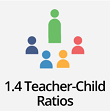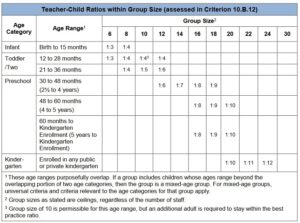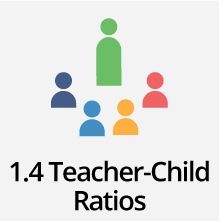
– How do I do this?
– What Barriers Might I Run Into and What Are Solutions?
– Where do I go for more resources?
– References
Back to Recommendations
Appropriate teacher-child ratios are one of the main aspects of a high-quality early childhood program. Studies show that lower class sizes and smaller teacher-child ratios may improve child outcomes, help reduce behavior problems, lower rates of special education placements, reduce teacher stress, and improve the teacher’s experience. Recent data also suggest that children of color are more likely than White children to be taught in preschools with teacher-child ratios that are too high. This lowers program quality and the quality of the teacher’s relationship with his or her children. Classrooms with higher teacher-child ratios are more likely to report expulsions and suspensions in state preschool programs. According to the National Prekindergarten Study, 12.7% of teachers with a classroom ratio of 12:1 or higher reported one of their children being expelled, compared with 7.7% of teachers with a classroom ratio of 8:1. Appropriate teacher-child ratios can promote stronger teacher-child relationships, improve child outcomes, and enhance the overall experience for both the teacher and children.
How do I do this?
Collect Data. Do you know what your class size data look like? Start by collecting data around your program’s class sizes and calculate a teacher-child ratio. Next, collect data around the number of suspensions and expulsions in your program, broken down by teacher-child ratio. How does your program’s ratio compare with your state’s recommendations or requirements? How does your program’s ratio compare with those recommended by NAEYC or the 2016 Head Start Program Performance Standards (see below)?
NAEYC Teacher-Child Ratios within the Group Size Chart

Head Start Program Performance Standards on Teacher-Child Ratios
| Center Based | 0-3 years | 8 | 1 Teacher for every 4 children | 1302.21(b)(2) |
| Center Based | 4-5 years | 17-20 children, with a maximum of 20 children enrolled in any one class. | 2 paid staff people per class – Teacher and Teacher Aide, or Two Teachers. | 1302.21(b)(3)(4) |
| 3 years | 15-17 children, with a maximum of 17 children enrolled in any one class. | |||
| 3 years | 13-15 children. With a maximum of 15 children | |||
| Home Based | 0-5 years old | Individual Family Home visit – One home visit per week that is at minimum 1.5 hour Provide, at minimum, 22 group solicitation activities over the course of the year |
Case Load of 10-12 children with a maximum of 12 | 1302.22(c) |
| Family Childcare | 0-5 years | With one child care provider: Maximum group size is 6 children with no more than 2 children under the age of 2. | Child Care Provider’s own children under the age of 6 must be counted in the ratio when they are home | 1302.23(b) |
| Infants and toddlers | One child care provider may care for 4 infants and toddlers with no more than 2 under the age of 18 months. |
Use the Data to Move Forward. Use these data to help assess your program’s needs and areas for improvement. Using the data you collected, consider the following questions provided by New York City’s Department of Education. These questions can help guide your next steps toward implementing a better teacher-child ratio. (The full article and list of questions can be found in the memo.)
- Where can I target class size reduction or other personalization efforts to impact the highest need populations?
- How can I optimize my budget to achieve class size reduction?
- How will class size reduction impact my staffing plan?
- How can I use my current space to open additional classes?
- Would creative scheduling of staff and space allow me to reduce class size or teacher-to-child ratio?
- What kinds of professional development/support will my staff need to ensure that children receive the full instructional benefits of reduced class sizes?
- If I plan to reduce my class sizes, how can I ensure that my smaller class sizes will be preserved in light of enrollment and facilities policies?
Taking gradual steps toward reducing class size will help keep cost increases small while promoting better child outcomes and teacher-child relationships. These data may also be used by public preschool programs and policy makers to advocate for more resources on a district, state, or national level.
Weigh the Costs and Benefits. Although there are costs that come with class size reduction, some of those added costs may be offset by savings that can be made from reducing teacher-child ratios. For example, staff turnover can be lowered when teacher-child ratios are smaller and classrooms more manageable. This reduction in turnover could reduce the costs associated with hiring and training of new staff members. Less supervision may also be required for teachers in smaller classes.
What Barriers Might I Run Into and What Are Solutions?
Potential Barrier: My program doesn’t have the resources to reduce teacher-child ratios.
Solutions: Although there is no set cost for class size reduction, many school programs may have difficulty finding the necessary resources. Parent volunteers and student teachers or interns may also be able to serve as aides in classrooms and offer additional support to providers/teachers.
Where do I go for more resources?
- Want to learn more on the benefits of small classroom size and low teacher-child ratios? Read Class Size: What’s the Best Fit? by Steven Barnett, Karen Schulman, and Rima Shore, published by the National Institute for Early Education Research.
- Curious about the return on the investment in reducing class size? Read the policy brief by the NEA Education Policy and Practice Department.
- Need a list of guiding questions to help your program plan for class size reduction? Check out a memo written by New York City’s Department of Education.
- Want to know what is the recommended ratio for your program? Take a look at the Teacher-Child Ratios suggested by NAEYC or 2016 Head Start Program Performance Standards.
References
Barnett, Steve., Schulman, Karen., and Shore, Rima. (2004). Class Size: What’s the Best Fit? National Institute for Early Education Research, 9, 1-12. Retrieved from http://nieer.org/resources/policybriefs/9.pdf
FCD Policy Brief Series, (3), 1-8. Retrieved from http://challengingbehavior.fmhi.usf.edu/explore/policy_docs/prek_expulsion.pdf
Hidden curriculum (2014, August 26). In S. Abbott (Ed.), The glossary of education reform. Retrieved from http://edglossary.org/hidden-curriculum
Howes, Carollee and Robert Pianta. (2005). Features of Pre-Kindergarten Programs, Classrooms, and Teachers: Do They Predict Observed Classroom Quality and Child-Teacher Interactions? Applied Developmental Science, 9(3), 144-159. Retrieved from http://www.leg.state.vt.us/PreKEducationStudyCommittee/Documents/impact%20of%20teacher%20and%20classroom%20quality.pdf
NEA. (2008). Class Size Reduction: A Proven Reform Strategy. NEA Education Policy and Practice Department. Retrieved from http://www.nea.org/assets/docs/PB08_ClassSize08.pdf
Rashid, H. M. (2009). From brilliant baby to child placed at risk: The perilous path of African American boys in early childhood education. The Journal of Negro Education, 78(3), 347-358,363. Retrieved from http://search.proquest.com.sri.idm.oclc.org/docview/222133586?accountid=166815
US Department of Health and Human Services and US Department of Education. (2014). Policy Statement on Expulsion and Suspension Policies in Early Childhood Settings. Retrieved from https://www2.ed.gov/policy/gen/guid/school-discipline/policy-statement-ece-expulsions-suspensions.pdf
